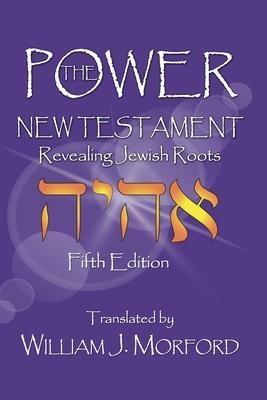The Power New Testament: Revealing Jewish Roots

The Power New Testament: Revealing Jewish Roots
The Power New Testament is from the One New Man Bible translation. The goal of the One New Man Bible is to bring a greater understanding of and appreciation for the Jewish roots of Christianity. This translation is part of an ongoing study to learn more about Who God is and to find the deeper meanings of Scripture. Because Jesus was, and still is (Hebrews 13:8), Jewish, as was every apostle, and every author of the New Testament, it was necessary to study much more than just the Greek language to do an accurate translation. This involves Hebrew language studies and the teachings of Jewish scholars to come as close as possible to what the Hebrew Scriptures meant to the New Testament authors. It is also important to learn about Hebrew idioms that are intact in the Greek text. A number of Bible scholars believe that at least the Gospels of Matthew, Mark, and Luke were originally written in Hebrew, partly because there are so many Hebrew idioms and so much Hebrew grammar in the Greek text. Whether or not those or other books of the New Testament were originally in Hebrew will not be explored here, but this translation makes every effort to translate those Hebrew expressions properly. Another goal of this translation is to point out Jewish customs that have often been missed and to explain the meanings of various customs.
Throughout the text of The Power New Testament, there are over 1,700 footnotes and includes access to the One New Man Bible online Glossary (https: //www.onenewmanbible.com/glossary/) to describe various first-century Jewish customs and to explain Hebrew Scriptures.
Many Jewish sources were studied. Among those were the Talmud, Mishna, Midrash, and Zohar, but the full list includes many modern Jewish commentaries that draw upon those four, but also quote numerous ancient and more recent sources. Those studies bring real depth to the subjects in the Glossary, but even more importantly, that study gives insight into the thinking of Jesus and the Apostles, especially the New Testament authors. It is important for those of us reading in the twenty-first century to understand what a word or expression meant to those who wrote the passages in the first century.
The Greek text used for this translation is the United Bible Societies' Fourth Edition, published in 1993. The editors used a scientific method called Textual Criticism to determine which of the more than five thousand ancient manuscripts of the New Testament were closest to wha
Descrierea produsului
The Power New Testament is from the One New Man Bible translation. The goal of the One New Man Bible is to bring a greater understanding of and appreciation for the Jewish roots of Christianity. This translation is part of an ongoing study to learn more about Who God is and to find the deeper meanings of Scripture. Because Jesus was, and still is (Hebrews 13:8), Jewish, as was every apostle, and every author of the New Testament, it was necessary to study much more than just the Greek language to do an accurate translation. This involves Hebrew language studies and the teachings of Jewish scholars to come as close as possible to what the Hebrew Scriptures meant to the New Testament authors. It is also important to learn about Hebrew idioms that are intact in the Greek text. A number of Bible scholars believe that at least the Gospels of Matthew, Mark, and Luke were originally written in Hebrew, partly because there are so many Hebrew idioms and so much Hebrew grammar in the Greek text. Whether or not those or other books of the New Testament were originally in Hebrew will not be explored here, but this translation makes every effort to translate those Hebrew expressions properly. Another goal of this translation is to point out Jewish customs that have often been missed and to explain the meanings of various customs.
Throughout the text of The Power New Testament, there are over 1,700 footnotes and includes access to the One New Man Bible online Glossary (https: //www.onenewmanbible.com/glossary/) to describe various first-century Jewish customs and to explain Hebrew Scriptures.
Many Jewish sources were studied. Among those were the Talmud, Mishna, Midrash, and Zohar, but the full list includes many modern Jewish commentaries that draw upon those four, but also quote numerous ancient and more recent sources. Those studies bring real depth to the subjects in the Glossary, but even more importantly, that study gives insight into the thinking of Jesus and the Apostles, especially the New Testament authors. It is important for those of us reading in the twenty-first century to understand what a word or expression meant to those who wrote the passages in the first century.
The Greek text used for this translation is the United Bible Societies' Fourth Edition, published in 1993. The editors used a scientific method called Textual Criticism to determine which of the more than five thousand ancient manuscripts of the New Testament were closest to wha
Detaliile produsului












